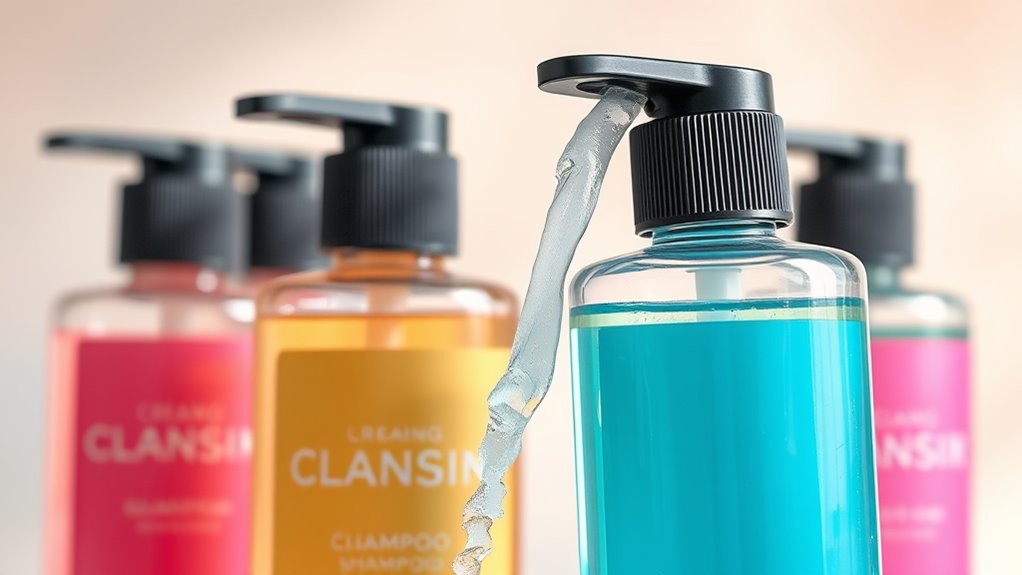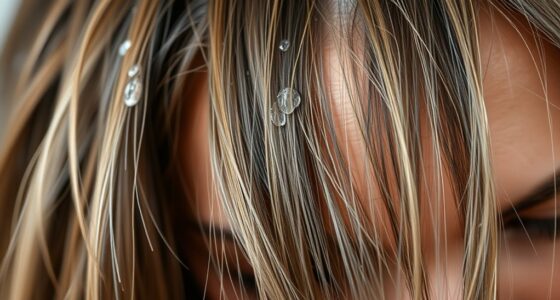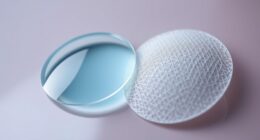If your hair feels heavy, greasy, or weighed down despite regular washing, a clarifying shampoo can help remove excess buildup from styling products, pollutants, and natural oils. Use it once a week or as needed, applying it thoroughly to wet hair, massaging gently into the scalp and strands. Be careful not to overuse, as it can strip natural oils and cause dryness. To learn more about proper application and precautions, keep exploring these tips.
Key Takeaways
- Use clarifying shampoo when hair feels greasy, heavy, or shows buildup from styling products and pollution.
- Apply thoroughly to wet hair, massaging into scalp and strands for deep cleansing.
- Use sparingly, typically once a week, to avoid stripping natural oils and causing dryness.
- Rinse completely and follow with conditioner or deep conditioning treatments to restore moisture.
- Reserve for periodic use to refresh hair, not as a daily shampoo, to maintain healthy scalp and hair.

If your hair feels dull, weighed down, or greasy despite regular washing, a clarifying shampoo might be just what you need. Over time, your scalp can accumulate buildup from styling products, environmental pollutants, and natural oils. This buildup, along with product residue, can clog hair follicles and prevent your strands from looking their best. Clarifying shampoos are specially formulated to deeply cleanse your scalp and hair, removing these impurities effectively. They’re not meant for daily use but are perfect for occasional use when your hair needs a reset.
If your hair feels dull or greasy, a clarifying shampoo can effectively remove buildup and refresh your strands.
You’ll want to use a clarifying shampoo when you notice your hair isn’t responding to regular cleansing or if you see signs of excess scalp buildup. If your hair feels heavy, sticky, or limp, it’s likely a sign that residue from styling products or environmental dirt is lingering. Using a clarifying shampoo can restore your hair’s natural bounce and shine by clearing out the gunk that regular shampoos leave behind. It’s especially useful if you frequently use styling products like gels, sprays, or waxes, as these tend to build up quickly.
When you’re ready to use a clarifying shampoo, start by thoroughly wetting your hair. Apply a generous amount and massage it gently into your scalp and hair, focusing on areas where buildup tends to accumulate. Unlike regular shampoos, which are milder, clarifying shampoos are designed for a deeper clean, so you might feel a slight tingling or a more intense lather. Be careful not to overdo it; using a clarifying shampoo more than once a week can strip your hair of its natural oils, leading to dryness and potential damage.
After massaging, rinse thoroughly to ensure all product residue and scalp buildup are washed away. Follow up with a conditioner to replenish moisture, especially if your hair feels dry after the clarifying wash. You might also consider using a deep conditioning treatment or hair mask a day after clarifying to restore hydration.
Frequently Asked Questions
Can Clarifying Shampoos Be Used Daily?
You shouldn’t use clarifying shampoos daily because they can strip your hair’s natural oils, especially if you have high hair porosity or scalp sensitivity. If your hair absorbs water quickly or feels dry or irritated, overusing clarifying shampoos can worsen these issues. Instead, use them once a week or as needed to remove buildup without compromising your scalp health or hair moisture balance.
Are Clarifying Shampoos Safe for Color-Treated Hair?
You’re wondering if clarifying shampoos are safe for your color-treated hair. The good news is, they can be, but only if you pay attention to ingredient sensitivity and prioritize color protection. These shampoos can strip away buildup without damaging your color if used sparingly and with gentle formulas. Just be cautious—overuse might fade your hue, so always choose a clarifying shampoo designed specifically for color-treated hair.
How Long Should I Leave a Clarifying Shampoo on My Scalp?
You should leave a clarifying shampoo on your scalp for about 1 to 3 minutes. If your scalp is sensitive, stick to the shorter time to avoid irritation. This allows the shampoo to effectively remove product buildup without over-stripping your hair or irritating your scalp. Be sure to rinse thoroughly, especially if you notice any redness or discomfort, to keep your scalp healthy and free from residue.
Can Clarifying Shampoos Help With Dandruff?
Think of clarifying shampoos as a gentle broom sweeping away product buildup. They can help with dandruff if your scalp irritation is caused by excess oils or residue. However, they aren’t a cure-all; overuse might dry out your scalp, worsening dandruff. Use them occasionally to refresh your scalp, but for persistent dandruff, consider a medicated shampoo or consult a dermatologist to target the root cause effectively.
Are There Natural Alternatives to Chemical Clarifying Shampoos?
Yes, natural alternatives to chemical clarifying shampoos include herbal rinses and apple cider vinegar. You can rinse your hair with a diluted herbal infusion, like chamomile or rosemary, to remove buildup gently. Apple cider vinegar, mixed with water, also works well to clarify your scalp and restore pH balance. These options are less harsh and can be integrated into your regular hair care routine for effective cleansing.
Conclusion
Using a clarifying shampoo can seem harsh, but when used correctly, it’s a game-changer for your hair. Just don’t overdo it—once a week is enough to keep buildup at bay without stripping your strands. If you’re worried about dryness, follow up with a conditioner or treatment. Trust me, your scalp will thank you for the fresh, clean feeling, and your hair will look brighter and healthier—no more dull, weighed-down locks!








